|
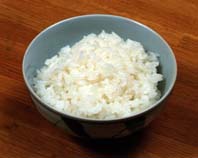
As was explained
earlier, rice is such an important part of of the Japanese diet that gohan,
the Japanese word for rice, refers to meals of all kinds. Rice isn't
considered a vegetable that's served with meat or fish, as in the West,
but an independent dish, eaten in its own bowl.


Short-grain rice (left) and its long-grain cousin.
|
The
type of rice Japanese people eat is short grain, which is different from
the long-grain variety that's enjoyed in most other parts of the world.
When cooked, short-grain rice is soft and moist while long-grain rice is
rather dry.
|

Here's
a traditional way to cook rice.
 (for
two to three servings) (for
two to three servings)
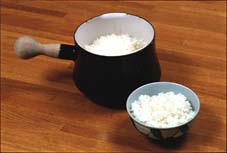
| Rice: |
2 cups |
| Water: |
2 1/4 cups |
|
|

Always
rinse the rice before cooking. Place the rice in a large
bowl and fill it with tap water.

Stir
the rice with your hand a few times and then drain the water
right away, being careful not to scatter the rice. Repeat
two times. Now stir the rice again, this time with less water in the
bowl, squeezing the rice in the palm of your hand as you
stir. Change the water periodically until all the rice
shavings have been washed off and the water stays clear even
when stirred.
Now stir the rice again, this time with less water in the
bowl, squeezing the rice in the palm of your hand as you
stir. Change the water periodically until all the rice
shavings have been washed off and the water stays clear even
when stirred.
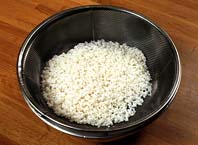 
Drain
off the water and let the rice stand on a sieve for about 30
minutes. This is to let the rice absorb the water on its
surface so that it cooks soft and moist.
|

|
|
|

Place
the rice and the measured water in a heavy pot,
cover with a tight-fitting lid, and cook over a
medium flame for around 5 minutes. Turn up the
flame until the steam begins spurting out from the
lid, at which point you should lower the gas to a
very low flame.

When all the water is absorbed,
turn off the gas and let stand for around 10 to 15
minutes with the lid on.

- Although the recipe
is for the kind of rice sold in Japan,
you can use similar varieties that are
grown in California and Spain
(Japonica).
- Be sure to use a
thick pot with a heavy lid. To cook 2
cups of rice, you'll need a pot that's
around 15 centimeters (6 inches) in
diameter and 12 centimeters (5 inches)
deep. The rice might spill over if the
pot's too shallow.
- You should adjust the
amount of water you use depending on
the type of rice and season. Rice
that's just been harvested needs less
water--about the same amount as the
rice.
- The instructions
above are for when cooking over a gas
burner. If you're using an electric
stove, turn off the switch when steam
starts spurting out from the lid and
allow the pot to stand for around 20
minutes.
- Lift the lid as
little as possible to keep the
temperature inside the pot from
falling and the steam from escaping.
If after cooking the rice is still
hard on the inside, you can place the
pot of rice with the lid on in a
moderately warm oven for about 10 to
15 minutes.
|
 |
|
|
|
|

|

Some different types of miso
|
 Miso
soup is made by mixing miso paste (a traditional flavoring)
and dashi (stock). The paste is made by fermenting
soy beans, rice or barley, and salt. There are different
kinds of miso depending on the region, just like
there are different varieties of cheese. The most common
type of miso is a light brown color, although there are also
some that are pale yellow and others that are dark brown.
The soup can be prepared with vegetables, meat, fish, tofu,
or any combination of these. Miso
soup is made by mixing miso paste (a traditional flavoring)
and dashi (stock). The paste is made by fermenting
soy beans, rice or barley, and salt. There are different
kinds of miso depending on the region, just like
there are different varieties of cheese. The most common
type of miso is a light brown color, although there are also
some that are pale yellow and others that are dark brown.
The soup can be prepared with vegetables, meat, fish, tofu,
or any combination of these.
|
|

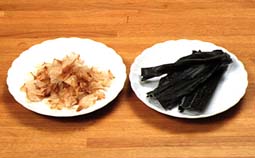
Bonito flakes (left) and Konbu (right)
|
Dashi
is stock generally made from konbu (kelp), dried
bonito (a kind of fish) flakes, or both. To complement the
taste of the miso, strong-flavored stock is used. Bonito
flakes are now available outside of Japan, so try making dashi
with them.

| Water: |
4 cups |
| Dried
bonito flakes: |
2 cups, loosely
packed
(20 to 30 grams, or around half an ounce) |
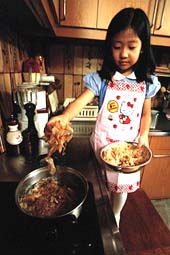
Bring
water to boil. Add bonito flakes and wait for the water to
boil again. Turn off the flame and remove the flakes with a
strainer.
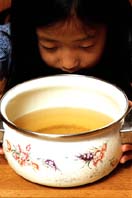
The dashi will look like this.
|

Concentrated stock is available at
stores selling Japanese foods in granular, powder, and
liquid form. You can use these, too, if you can get hold
of them. While the amount you use will be different
according to the type of dashi, figure on adding around
two teaspoons for around three cups of water.
|
|



